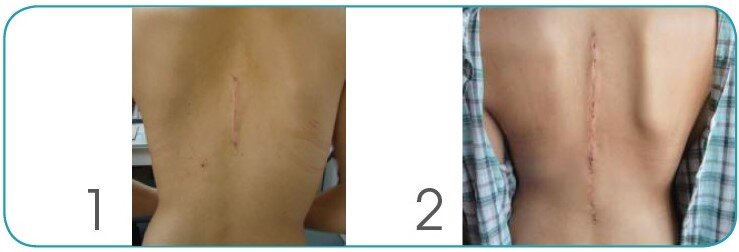The ApiFix System - Patient Information
The Adolescent Idiopathic Scoliosis (AIS) denotes a deformation of the spine in adolescence, between 10 and 18 years. The cause of it is unknown. The severity of scoliosis is measured in degrees-called Cobb angle. The scoliosis in adolescents that is up to 20° is treated by Physiotherapy.
For scoliosis between 20 and 35 degrees the recommended treatment is a corset, where the goal is to stop curve progression. Surgical treatment of scoliosis with Long Spinal Fusion is recommended for Cobb angle of 45° or more, as at that severity level there is a high risk of deformity progression in the course of a life.
The ApiFix concept
ApiFix offers the Internal Brace System, which is a minimal invasive, non-fusion, option for AIS patients having Cobb angle between 40 and 55 degrees. The procedure is aimed to reduce the curve to the point where the risk for deformity progression is very low. The ApiFix correction procedure basically consists of 2 phases.
The first phase is Implantation of the ApiFix System, which in comparison to the conventional surgical procedure is much less invasive.
The second phase is the postoperative gradual correction of the deformity by means of a physiotherapy treatment, done by the patient at home.
Why ApiFix Mid-C as opposed to Traditional Standard treatment ?
Figure 1- after ApiFix procedure Figure 2- longer scar after standard surgical correction of adolescent scoliosis. The benefits of Long Spinal Fusion with pedicle screws system are the good curve correction and the good clinical results.
Disadvantages of Long Spinal Fusion surgery:
In addition to the significant operation trauma, there is a permanent long spinal fusion. This adversely affects the mobilityof the spine and the adjacent discs are subjected to the risk of damage and accelerated degeneration process. The procedure is very aggressive and results long hospital stay and long healing process. Cosmetically this treatment is associated with a long scar.
Hospitalization after the ApiFix operation usually takes approximately 2-4 days. Two weeks after the surgery the patient will be educated to do, at home, 5-6 simple exercises based on the Schroth method. Physiotherapy is continued until sufficient correction is gained, typically 3 to 6 months. The ApiFix implant has a simple mechanism which maintains any minor correction gained by the patient. After any minimal gradual correction the soft tissues are allowed to adapt to the new situation. Physiotherapy is continued until sufficient correction is gained.
In contrast to the long spinal fusion operation with intraoperative correction of the spine at one aggressive operation, where some spinal mobility is permanently lost, with the ApiFix system the mobility of the individual vertebra is maintained.







